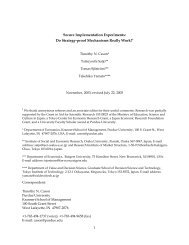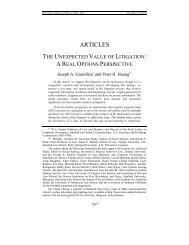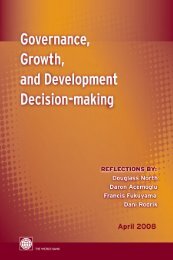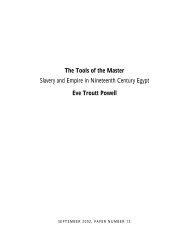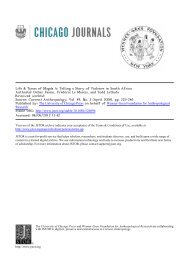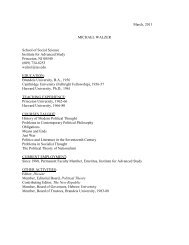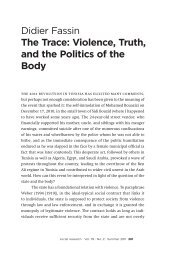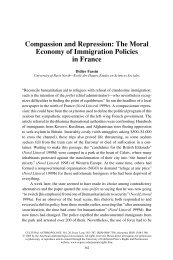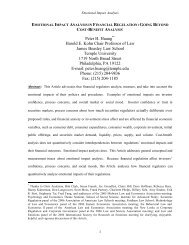Unanswered Questions - School of Social Science - Institute for ...
Unanswered Questions - School of Social Science - Institute for ...
Unanswered Questions - School of Social Science - Institute for ...
Create successful ePaper yourself
Turn your PDF publications into a flip-book with our unique Google optimized e-Paper software.
<strong>Unanswered</strong> <strong>Questions</strong><br />
Author(s): By Joan W. Scott<br />
Reviewed work(s):<br />
Source: The American Historical Review, Vol. 113, No. 5 (December 2008), pp. 1422-1430<br />
Published by: The University <strong>of</strong> Chicago Press on behalf <strong>of</strong> the American Historical Association<br />
Stable URL: http://www.jstor.org/stable/10.1086/ahr.113.5.1422 .<br />
Accessed: 07/09/2012 10:27<br />
Your use <strong>of</strong> the JSTOR archive indicates your acceptance <strong>of</strong> the Terms & Conditions <strong>of</strong> Use, available at .<br />
http://www.jstor.org/page/info/about/policies/terms.jsp<br />
.<br />
JSTOR is a not-<strong>for</strong>-pr<strong>of</strong>it service that helps scholars, researchers, and students discover, use, and build upon a wide range <strong>of</strong><br />
content in a trusted digital archive. We use in<strong>for</strong>mation technology and tools to increase productivity and facilitate new <strong>for</strong>ms<br />
<strong>of</strong> scholarship. For more in<strong>for</strong>mation about JSTOR, please contact support@jstor.org.<br />
.<br />
The University <strong>of</strong> Chicago Press and American Historical Association are collaborating with JSTOR to<br />
digitize, preserve and extend access to The American Historical Review.<br />
http://www.jstor.org
AHR Forum<br />
<strong>Unanswered</strong> <strong>Questions</strong><br />
JOAN W. SCOTT<br />
WHEN I SUBMITTED MY “GENDER” ARTICLE to the AHR in 1986, its title was “Is Gender<br />
a Useful Category <strong>of</strong> Historical Analysis?” The editors made me turn the question<br />
into a statement because, they said, interrogatives were not allowed in article titles.<br />
Dutifully, I complied with this convention, though I thought the revision eliminated<br />
a certain rhetorical punch. Some twenty years later, the articles prepared <strong>for</strong> this<br />
<strong>for</strong>um seem to answer the question in the affirmative, and they do so with a rich<br />
variety <strong>of</strong> examples from recent historical writing. At the same time, they suggest that<br />
questions about gender are never completely answered; indeed, I want to insist that<br />
the term gender is useful only as a question.<br />
As I read the articles, I couldn’t help remembering the scowls that greeted the<br />
initial presentation <strong>of</strong> the paper, at a seminar at the <strong>Institute</strong> <strong>for</strong> Advanced Study<br />
in the fall <strong>of</strong> 1985. The Princeton historians had turned out to hear my talk—my first<br />
as a newly appointed member <strong>of</strong> the <strong>Institute</strong> faculty—and they were, to a man,<br />
appalled. Arms folded tightly across their chests, they drew themselves farther and<br />
farther back in their chairs and then left without a word. Later, some <strong>of</strong> their comments<br />
were reported back to me by friendly colleagues. Philosophy, not history,<br />
opined Lawrence Stone to all who would listen. I was spared the more negative<br />
reactions, though they were evident in that resounding silence. The establishment<br />
was clearly ready neither <strong>for</strong> gender nor <strong>for</strong> the poststructuralist theory that helped<br />
me <strong>for</strong>mulate my ideas. I was shaken, but undaunted, since thinking in these new<br />
ways was far too interesting to send me back to orthodox history.<br />
At the meetings <strong>of</strong> the American Historical Association in December, the paper<br />
got an entirely different reaction: critical but engaged responses from feminists, historians<br />
<strong>of</strong> women, and the growing band <strong>of</strong> our supporters. I was giving voice to—not<br />
inventing—some <strong>of</strong> the ideas and questions that the feminist movement had posed,<br />
looking <strong>for</strong> ways to turn political questions into historical ones. The paper was an<br />
amalgam <strong>of</strong> two sets <strong>of</strong> influences, one coming from history, the other from literature.<br />
The history side was the product <strong>of</strong> those amazing early Berkshire Conferences<br />
on the History <strong>of</strong> Women in the 1970s. It was there that I first heard mention<br />
<strong>of</strong> gender, in a talk by Natalie Zemon Davis, who reminded us that “women” were<br />
always defined in some relation to men. “Our goal,” she said, “is to understand the<br />
significance <strong>of</strong> the sexes, <strong>of</strong> gender groups in the historical past. Our goal is to discover<br />
the range in sex roles and in sexual symbolism in different societies and periods,<br />
to find out what meanings they had and how they functioned to maintain the<br />
1422
<strong>Unanswered</strong> <strong>Questions</strong> 1423<br />
social order or to promote change.” 1 The literary side was a result <strong>of</strong> my time at<br />
Brown University in the early 1980s, working with feminist poststructuralist and psychoanalytic<br />
critics, among them Elizabeth Weed, Naomi Schor, Mary Anne Doane,<br />
and Ellen Rooney. They taught me how to think about the productive operations <strong>of</strong><br />
difference, to understand that differences <strong>of</strong> sex were not set by nature but were<br />
established through language, and to analyze language as a volatile, mutable system<br />
whose meanings could never finally be secured.<br />
I think it’s right that the authors <strong>of</strong> the <strong>for</strong>um pieces remind us that I was not<br />
the origin <strong>of</strong> the gender concept, even among historians, but that my paper was a<br />
site where several lines <strong>of</strong> thought converged. “Joan Scott” is not, from this perspective,<br />
a person, but a placeholder, a representative <strong>for</strong> a collective endeavor <strong>of</strong><br />
which I (Joan Scott the person) was only a part. That’s probably why the article has<br />
endured: it had a familiar resonance, even <strong>for</strong> readers who did not agree with all <strong>of</strong><br />
its arguments and who had no intention <strong>of</strong> following its suggestions. It set out some<br />
terms that we had to contend with, some theories that had to be engaged, and above<br />
all, it captured something <strong>of</strong> the excitement <strong>of</strong> those times: a way beyond ideas that<br />
had become stifling or stale, a set <strong>of</strong> openings to knowledge that we had yet to produce.<br />
“Gender” is about asking historical questions; it is not a programmatic or<br />
methodological treatise. It is above all an invitation to think critically about how the<br />
meanings <strong>of</strong> sexed bodies are produced, deployed, and changed; that, finally, is what<br />
accounts <strong>for</strong> its longevity.<br />
The articles prepared <strong>for</strong> this <strong>for</strong>um testify to the myriad uses <strong>of</strong> the concept <strong>of</strong><br />
gender as a way <strong>of</strong> interrogating history. They insist on the importance <strong>of</strong> context—<br />
temporal, geographic, political, ideological—<strong>for</strong> understanding the analyses it has<br />
enabled. No simple characterization can be based on the work they report. It’s not<br />
a matter <strong>of</strong> how historians in and <strong>of</strong> different countries and eras rightly or wrongly<br />
applied some original idea <strong>of</strong> gender. As Heidi Tinsman puts it, “what constitutes<br />
useful categories <strong>of</strong> feminist analysis is a matter <strong>of</strong> geopolitics rather than epistemological<br />
catch-up.” Another way to say this is that questions about gender can be<br />
asked and answered only in specific contexts. It is evident from these articles that<br />
gender is not a universally applicable concept with fixed parameters or referents; like<br />
“class,” it is most useful when it points the way to specific investigations <strong>of</strong> meanings,<br />
whether <strong>of</strong> social relationships or rhetorical proclamations. There is no “language<br />
<strong>of</strong> gender” whose import can be extracted from its usages in order to measure its<br />
impact in good social scientific fashion. There are only diverse usages whose meanings<br />
must be read. And all that these readings can <strong>of</strong>fer is deeper insight into the<br />
history we study, whatever its period or topic.<br />
One <strong>of</strong> the striking things about these articles is their emphasis on the ways historians<br />
have looked at ideas about men and women, masculine and feminine, in order<br />
to illuminate politics writ large: war, empire, states, nations and nationalism, racism,<br />
revolution, resistance, communism and post-communism, party conflict, economic<br />
development. Various representations <strong>of</strong> masculinity and femininity have been invoked<br />
to mobilize constituencies, to tar enemies, to put groups and individuals in<br />
their place. Gender is, after all, “a primary way <strong>of</strong> signifying power.” Two decades<br />
1<br />
Natalie Zemon Davis, “ ‘Women’s History’ in Transition: The European Case,” Feminist Studies<br />
3, no. 3–4 (1976): 90.<br />
AMERICAN HISTORICAL REVIEW DECEMBER 2008
1424 Joan W. Scott<br />
<strong>of</strong> research has made it abundantly clear that (to quote “Joan Scott”) “gender constructs<br />
politics.”<br />
But oddly, or perhaps predictably, there are fewer questions posed about the ways<br />
in which “politics constructs gender,” about the changing meanings <strong>of</strong> “women” (and<br />
“men”), and about the ways they are articulated by and through other concepts that<br />
seemingly have nothing to do with sex (such as war, race, citizen, reason, spirituality,<br />
nature, or the universal). Attention to gender, which emanated from the field <strong>of</strong><br />
women’s history, has not so much historicized “women” as it has worked with a fixed<br />
meaning <strong>for</strong> the category, taking the physical commonality <strong>of</strong> females as a synonym<br />
<strong>for</strong> a collective entity designated “women.” Gender is said to be about the relationship<br />
between women and men, assumed to be not only hierarchical, but invariably<br />
so; the particular terms used to depict the relationship are seemingly less important<br />
than the asymmetry itself. And despite much innovative research on<br />
sexuality, gender—at least in historical discourse—most <strong>of</strong>ten refers to sexual difference,<br />
to an enduring male/female opposition, a normatively (if not distinctly biological)<br />
heterosexual coupling, even when homosexuality is the topic being addressed.<br />
It’s not that women aren’t given a history; <strong>of</strong> course they are. Ideas about<br />
them are said to change, as do their experiences; these vary in time and by class,<br />
ethnicity, culture, religion, and geography. The bountiful literature on women’s social<br />
history is full <strong>of</strong> important distinctions that insist on the particularity <strong>of</strong> working<br />
or peasant or lesbian or medieval or Jewish or African American or Muslim or Latino<br />
or Eastern European women. But however much they attend to the quotidian lives<br />
<strong>of</strong> diverse populations, these differences take <strong>for</strong> granted an “underlying continuity<br />
<strong>of</strong> real women above whose constant bodies changing aerial descriptions dance.” 2<br />
Paradoxically, the history <strong>of</strong> women has kept “women” outside history. And the result<br />
is that “women” as a natural phenomenon is reinscribed, even as we assert that<br />
women are discursively constructed. To put it another way, the sex/gender binary,<br />
which defined gender as the social assignment <strong>of</strong> meaning to biologically given sex<br />
differences, remains in place despite a generation <strong>of</strong> scholarship aimed at deconstructing<br />
that opposition. (The deconstruction insisted that sex, like gender, had to<br />
be understood as a system <strong>of</strong> attributed meaning. Neither was about nature; both<br />
were products <strong>of</strong> culture. Sex was not a transparent phenomenon; it acquired its<br />
natural status retrospectively, as justification <strong>for</strong> the assignment <strong>of</strong> gender roles.) As<br />
long as “women” continue to “<strong>for</strong>m a passive backdrop to changing conceptions <strong>of</strong><br />
gender,” our history will rest on a biological foundation that feminists—theoretically,<br />
at least—want to contest. 3<br />
This was the argument, already two decades ago, <strong>of</strong> Denise Riley’s “Am I That<br />
Name?” Feminism and the Category <strong>of</strong> “Women” in History. It was published in 1988,<br />
the same year as my Gender and the Politics <strong>of</strong> History. 4 The two books share a similar<br />
concern with feminism and history; both turn to poststructuralist theory <strong>for</strong> help;<br />
each speaks to the other. While my book addresses the question <strong>of</strong> gender as an<br />
analytic category, Riley’s takes on the task <strong>of</strong> treating “women” in the same way. She<br />
2<br />
Denise Riley, “Am I That Name?” Feminism and the Category <strong>of</strong> “Women” in History (London,<br />
1988), 7.<br />
3<br />
Ibid.<br />
4<br />
Joan Wallach Scott, Gender and the Politics <strong>of</strong> History (1988; 2nd ed., New York, 1999).<br />
AMERICAN HISTORICAL REVIEW DECEMBER 2008
<strong>Unanswered</strong> <strong>Questions</strong> 1425<br />
<strong>of</strong>fers a Foucauldian genealogy <strong>of</strong> “women”—a term more <strong>of</strong>ten treated as a transparent<br />
description. Even as she distinguishes “female persons” from “women,” her<br />
reading has <strong>of</strong>ten been mistaken <strong>for</strong> “a sort <strong>of</strong> Woman through the Ages approach”—something<br />
she specifically wanted to avoid. 5 That this has been the case<br />
is a measure <strong>of</strong> how resistant history as a discipline has been to Foucault’s radical<br />
epistemological challenge, and also how well-disciplined history’s seemingly rebellious<br />
daughters have turned out to be.<br />
It is worth considering Riley’s arguments a bit more because they illustrate a way<br />
to implement “Joan Scott’s” exhortation to ask not only how gender constructs politics,<br />
but how politics constructs gender. Politics, in that phrase, stands <strong>for</strong> more than<br />
power relations; it refers to the “external” influences on conceptions <strong>of</strong> women and<br />
men that apparently have nothing to do with them—notions <strong>of</strong> the soul or the universal<br />
or the human, <strong>for</strong> example, or <strong>of</strong> reason, imagination, science, and desire.<br />
Asking how “women” are defined in relation to ideas such as these is, <strong>for</strong> me, part<br />
<strong>of</strong> the unfinished business <strong>of</strong> the trans<strong>for</strong>mation in historical consciousness that the<br />
“Gender” article has come to signify.<br />
Riley’s book is addressed to feminists, and to the difficulty posed <strong>for</strong> us by the<br />
need at once to insist on and to refuse the identity <strong>of</strong> “women.” This, she maintains,<br />
is not a liability, but the condition that gives rise to feminism. “ ‘Women’ is indeed<br />
an unstable category . . . this instability has a historical foundation, and . . . feminism<br />
is the site <strong>of</strong> the systematic fighting-out <strong>of</strong> that instability.” It is not only that there<br />
are different kinds <strong>of</strong> women assembled under the term, but also that the collective<br />
identity means different things at different times. Even <strong>for</strong> individuals, one is not<br />
always conscious <strong>of</strong> “being a woman.” The identity, Riley says, does not pervade us<br />
and so is “inconstant, and can’t provide an ontological foundation.” “The body”<br />
doesn’t provide that foundation either, since it is itself a concept that must be “read<br />
in relation to whatever else supports and surrounds it.” “For all its corporeality,”<br />
Riley points out, the body is not “an originating point nor yet a terminus; it is a result<br />
or an effect.” 6<br />
The absence <strong>of</strong> an ontological foundation might suggest the futility <strong>of</strong> women’s<br />
history; if there are no women, some <strong>of</strong> her critics have complained, how can there<br />
be women’s history, or <strong>for</strong> that matter, feminism? 7 In fact, Riley makes “women” the<br />
object <strong>of</strong> historical investigation. She asks when the category comes under discussion<br />
and in what terms, and she points to the ways in which, at different historical moments,<br />
there have been different kinds <strong>of</strong> openings created <strong>for</strong> feminist claims. “The<br />
arrangements <strong>of</strong> people under the banners <strong>of</strong> ‘men’ or ‘women’ are enmeshed in the<br />
histories <strong>of</strong> other concepts too, including those <strong>of</strong> ‘the social’ and ‘the body.’ And<br />
that has pr<strong>of</strong>ound repercussions <strong>for</strong> feminism.” 8 Riley shows how, in early modern<br />
Europe, notions <strong>of</strong> the androgynous soul defined one kind <strong>of</strong> relation <strong>of</strong> “women”<br />
to humanity, whereas by the eighteenth century, attention to nature and the body<br />
led to an increasing emphasis on women’s sexuality. As “the social” found a place<br />
between “the domestic” and “the political” in the nineteenth century, it “established<br />
5<br />
Riley, “Am I That Name?” 7.<br />
6<br />
Ibid., 5, 2, 104, 102.<br />
7<br />
See, <strong>for</strong> example, Tania Modleski, Feminism without Women: Culture and Criticism in a “Postfeminist”<br />
Age (New York, 1991).<br />
8<br />
Riley, “Am I That Name?” 7.<br />
AMERICAN HISTORICAL REVIEW DECEMBER 2008
1426 Joan W. Scott<br />
‘women’ as a new kind <strong>of</strong> sociological collectivity.” 9 And, <strong>of</strong> course, until individuals<br />
were defined as political subjects, there could be no claim <strong>for</strong> citizenship or political<br />
rights <strong>for</strong> women. It’s not just that women have different kinds <strong>of</strong> possibilities in their<br />
lives, but that “women” is something different in each <strong>of</strong> these moments. There is<br />
no essence <strong>of</strong> womanhood (or <strong>of</strong> manhood) to provide a stable subject <strong>for</strong> our histories;<br />
there are only successive iterations <strong>of</strong> a word that doesn’t have a fixed referent<br />
and so doesn’t mean the same thing.<br />
DYAN ELLIOTT’S ESSAY DEMONSTRATES THIS as she reviews the work <strong>of</strong> Caroline Bynum<br />
and others on the gender fluidity <strong>of</strong> medieval spirituality: Christ as mother; viragos<br />
designated honorary men; lay brethren casting themselves in the image <strong>of</strong> female<br />
mystics. Medical discourse, she tells us, insisted that biological factors undermined<br />
“the stability <strong>of</strong> sexual binaries . . . the medieval categories male and female emerge<br />
as extremely fragile constructs, mere accidents <strong>of</strong> heat and moisture, ever-threatening<br />
to collapse into one another.” Even if this led theologians to insist more firmly<br />
on maintaining male/female distinctions in other arenas, one sees that the distinctions<br />
are not the same as those <strong>of</strong>fered by today’s church fathers. And objections to<br />
those distinctions, however eloquent and courageous, could not have been the same<br />
as those that feminists would make today, despite Elliott’s claim that their fragility<br />
is “in eerie anticipation <strong>of</strong> contemporary science’s destabilization <strong>of</strong> sex as presented<br />
by writers such as Anne Fausto-Sterling.” “Women” in the Middle Ages were not<br />
“women” as we think <strong>of</strong> them today; and this has important implications <strong>for</strong> the way<br />
we study women and write their history. It is not enough to illuminate material life<br />
in all its facets. <strong>Social</strong> histories <strong>of</strong> family structure or religious institutions or economic<br />
exchange are incomplete without attention to the question <strong>of</strong> how the collectivity<br />
named “women” comes into existence, who counts as included in that collectivity,<br />
and when its nature and behavior become a matter <strong>of</strong> concern.<br />
It is interesting that there is a great deal <strong>of</strong> attention paid to the difficulty <strong>of</strong><br />
translating the term gender into languages in which it doesn’t exist, but there’s no<br />
apparent problem with women. That’s because gender is taken to be a conceptual<br />
category, while women is thought to be a descriptive term. Yet what “Gender” (the<br />
article) actually does is posit “women” and “men” as conceptual categories. It refuses<br />
the idea that those two words transparently describe enduring objects (or bodies) and<br />
instead asks how those bodies are thought. It assumes, with Foucault, that bodies<br />
are “totally imprinted by history” and that “nothing in man, not even his body, is<br />
sufficiently stable to serve as the basis <strong>for</strong> self-recognition or <strong>for</strong> understanding other<br />
men.” 10 Riley elaborates this point <strong>for</strong> the admittedly different bodies <strong>of</strong> women:<br />
we would need to maintain that women only sometimes live in the flesh distinctively <strong>of</strong> women,<br />
as it were, and this is a function <strong>of</strong> historical categorisations as well as <strong>of</strong> an individual daily<br />
phenomenology. To say that is by no means to deny that because <strong>of</strong> the cyclical aspects <strong>of</strong><br />
female physiology, there may be a greater overall degree <strong>of</strong> slipping in and out <strong>of</strong> the consciousness<br />
<strong>of</strong> the body <strong>for</strong> many women. But even this will always be subject to different<br />
9<br />
Ibid., 50.<br />
10<br />
Michel Foucault, “Nietzsche, Genealogy, History,” in Donald F. Bouchard and Sherry Simon, eds.<br />
and trans., Language, Counter-Memory, Practice: Selected Essays and Interviews (Ithaca, N.Y., 1977), 148.<br />
AMERICAN HISTORICAL REVIEW DECEMBER 2008
<strong>Unanswered</strong> <strong>Questions</strong> 1427<br />
interpretations, and nothing more radical than the facts <strong>of</strong> intermittent physiology really holds<br />
the bodies <strong>of</strong> women together . . . The body becomes visible as a body, and as a female body,<br />
only under some particular gaze—including that <strong>of</strong> politics. 11<br />
It was feminist politics that brought “women” into view as an object <strong>of</strong> historical<br />
investigation. But, ironically, the project <strong>of</strong> creating a subject <strong>for</strong> contemporary feminism<br />
(an active, protesting collectivity, asserting their rights, seeking emancipation<br />
from oppression) tended to blur the lines <strong>of</strong> difference, whether temporal, cultural,<br />
or social. “Gender” was meant to historicize and relativize women and to conceive<br />
<strong>of</strong> them as integral to history, not simply as agents, but as “women.” The point was<br />
that the current subject <strong>of</strong> feminism (our collectivity) could not be projected retrospectively<br />
or laterally. Global feminism is an imaginary unity, a political vision, not<br />
an entity that preexists its articulation. “Gender” suggested that we had to problematize<br />
the very notion <strong>of</strong> how we came to think <strong>of</strong> ourselves in the way we did.<br />
It was not self-evident that women were conscious <strong>of</strong> themselves as “women,” not<br />
at all clear that “our bodies” defined “ourselves.” There was no “false consciousness”<br />
about what it meant to be a woman (even if consciousness-raising was a mobilizing<br />
technique). Rather, there were appeals to specific interests and experiences that, at<br />
a particular moment, got organized under the sign <strong>of</strong> “women.” The questions were,<br />
how and when did that happen, and under what conditions? To understand feminism<br />
(in its current and its historical manifestations), one had to think <strong>of</strong> it as a strategic<br />
intervention in a set <strong>of</strong> discourses that were not restricted to “women.”<br />
Although there was a great deal <strong>of</strong> concern voiced about whether gender, added<br />
to or substituted <strong>for</strong> women (in book titles and course curricula), would weaken<br />
feminist claims, in fact gender signaled a deepening <strong>of</strong> the commitment to the history<br />
both <strong>of</strong> women and <strong>of</strong> “women.” I am arguing that no history <strong>of</strong> women is complete<br />
without a history <strong>of</strong> “women.” “Gender” was a call to disrupt the powerful pull <strong>of</strong><br />
biology by opening every aspect <strong>of</strong> sexed identity to interrogation, including the<br />
question <strong>of</strong> whether or not male/female, masculine/feminine was the contrast being<br />
invoked. Riley reminds us that the insistence on the fixity <strong>of</strong> that opposition (on the<br />
essential “truth” <strong>of</strong> sexual difference) is itself the product <strong>of</strong> a certain history, and<br />
not one we should consider inviolate. Indeed, the tripartite hierarchies invoked by<br />
Dyan Elliott suggest that there were (and are) other terms than binary ones <strong>for</strong><br />
thinking about how gender and sexuality have been imagined and lived.<br />
JOANNE MEYEROWITZ WRITES IN HER CONTRIBUTION to this <strong>for</strong>um that when I “questioned<br />
the ongoing vitality <strong>of</strong> the term ‘gender’ ” in the 1999 edition <strong>of</strong> Gender and<br />
the Politics <strong>of</strong> History, I was “mov[ing] in new directions.” That’s not exactly right.<br />
Nor, in my book on the French feminist movement, Parité, did I focus “less on the<br />
language <strong>of</strong> sex difference and more on the language <strong>of</strong> universalism in contemporary<br />
France.” 12 My ongoing concern is with the question <strong>of</strong> how the differences<br />
between the sexes are conceived and what the effects <strong>of</strong> that construction are,<br />
11<br />
Riley, “Am I That Name?” 105–106.<br />
12<br />
Joan Wallach Scott, Parité! Sexual Equality and the Crisis <strong>of</strong> French Universalism (Chicago, 2005),<br />
10.<br />
AMERICAN HISTORICAL REVIEW DECEMBER 2008
1428 Joan W. Scott<br />
whether the object <strong>of</strong> analysis is French universalism, feminist movements, or the<br />
politics <strong>of</strong> the veil. It is true that in 1999 I was worrying about the fact that gender<br />
had “lost its critical edge,” and so its ability to problematize historical materials.<br />
Instead <strong>of</strong> asking how differences were constructed and in what terms, it referred<br />
increasingly to an unchanging, taken-<strong>for</strong>-granted opposition between women and<br />
men. According to the American Heritage Dictionary, the nature/culture distinction<br />
between sex and gender did not apply to ordinary usage: gender had become synonymous<br />
with sex or the difference between the sexes. The very language that needed<br />
to be analyzed was being used to reinscribe the biological body as the ground on<br />
which gender was constructed. The question was, and is, how can we disrupt that<br />
fixed association in the history we write?<br />
Perhaps it is sexual difference that now needs to be problematized so that gender<br />
can be freed to do its critical work. For this I’ve found it useful to turn to psychoanalytic<br />
theory, not to its conservative articulations (which have, among other things,<br />
been used to shore up the heterosexual family as the key to normal psyches and stable<br />
cultures), but to the places where it addresses the difficulties associated with establishing<br />
the boundaries and meanings <strong>of</strong> sexed identities. On the one hand, “the<br />
psychic knowledge <strong>of</strong> sexual difference . . . is something one cannot not know.” 13 On<br />
the other hand, there is no certain knowledge <strong>of</strong> what it means. Its meanings are<br />
<strong>of</strong>fered in the realms <strong>of</strong> individual fantasy and collective myth, and these aren’t<br />
necessarily in sync with one another; nor do they determine the ways in which subjects<br />
relate to masculinity or femininity (assuming it, refusing it, rejecting the divide<br />
between them). Psychoanalysis sees no necessary correspondence between the psychic<br />
positions <strong>of</strong> masculinity and femininity and a physical body; indeed, it is “the<br />
body that comes to represent the psychic realization <strong>of</strong> sexual difference and not the<br />
reverse.” 14 The theory posits no fixed definition <strong>for</strong> masculine/feminine or <strong>for</strong> the<br />
differences between them; rather, it requires analysis to get at what they mean.<br />
Of course, the analysis aims at uncovering the idiosyncratic meanings developed<br />
by individual psyches, but these are not <strong>for</strong>ged independent <strong>of</strong> the conscious awareness<br />
<strong>of</strong> normative categories and their en<strong>for</strong>cement. Nor are the normative categories<br />
simply rational statements <strong>of</strong> desirable identification. They are attempts to<br />
eliminate the psychic confusion that sexual difference generates, to bring individual<br />
fantasy in line with cultural myth and social organization. Gender, I would argue,<br />
is the study <strong>of</strong> the relationship (around sexuality) between the normative and the<br />
psychic, the attempt at once to collectivize fantasy and to use it <strong>for</strong> some political<br />
or social end, whether that end is nation-building or family structure. In the process,<br />
it is gender that produces meanings <strong>for</strong> sex and sexual difference, not sex that determines<br />
the meanings <strong>of</strong> gender. If that is the case, then (as some feminists have<br />
long insisted) not only is there no distinction between sex and gender, but gender<br />
is the key to sex. And if that is the case, then gender is a useful category <strong>of</strong> historical<br />
analysis because it requires us to historicize the ways that sex and sexual difference<br />
have been conceived.<br />
13<br />
Elizabeth Weed, “Joan W. Scott’s Useful Category <strong>of</strong> Analysis” (paper presented at the conference<br />
“In Terms <strong>of</strong> Gender,” held at the Center <strong>for</strong> 21st Century Studies at the University <strong>of</strong> Wisconsin,<br />
Milwaukee, May 4–5, 2007), 6.<br />
14<br />
Ibid.<br />
AMERICAN HISTORICAL REVIEW DECEMBER 2008
<strong>Unanswered</strong> <strong>Questions</strong> 1429<br />
The “language <strong>of</strong> gender” cannot be codified in dictionaries; nor can its meanings<br />
be easily assumed or translated. It doesn’t reduce to some known quantity <strong>of</strong> masculine<br />
or feminine, male or female. It’s precisely the particular meanings that need<br />
to be teased out <strong>of</strong> the historical materials we examine. When gender is an open<br />
question about how these meanings are established, what they signify, and in what<br />
contexts, it remains a useful category <strong>of</strong> historical analysis. Perhaps that question<br />
mark I had to remove from the title <strong>of</strong> the AHR article ought to have remained after<br />
all, if only to remind us that gender itself is a question that is only ever answered<br />
piecemeal through the investigations <strong>of</strong> scholars, historians among them.<br />
Joan W. Scott is Harold F. Linder Pr<strong>of</strong>essor <strong>of</strong> <strong>Social</strong> <strong>Science</strong> at the <strong>Institute</strong><br />
<strong>for</strong> Advanced Study in Princeton, N.J. Among her books are The Glassworkers<br />
<strong>of</strong> Carmaux: French Craftsmen and Political Action in a Nineteenth-Century City<br />
(Harvard University Press, 1974), Gender and the Politics <strong>of</strong> History (Columbia<br />
University Press, 1988), and most recently The Politics <strong>of</strong> the Veil (Princeton<br />
University Press, 2008).<br />
AMERICAN HISTORICAL REVIEW DECEMBER 2008
1430



